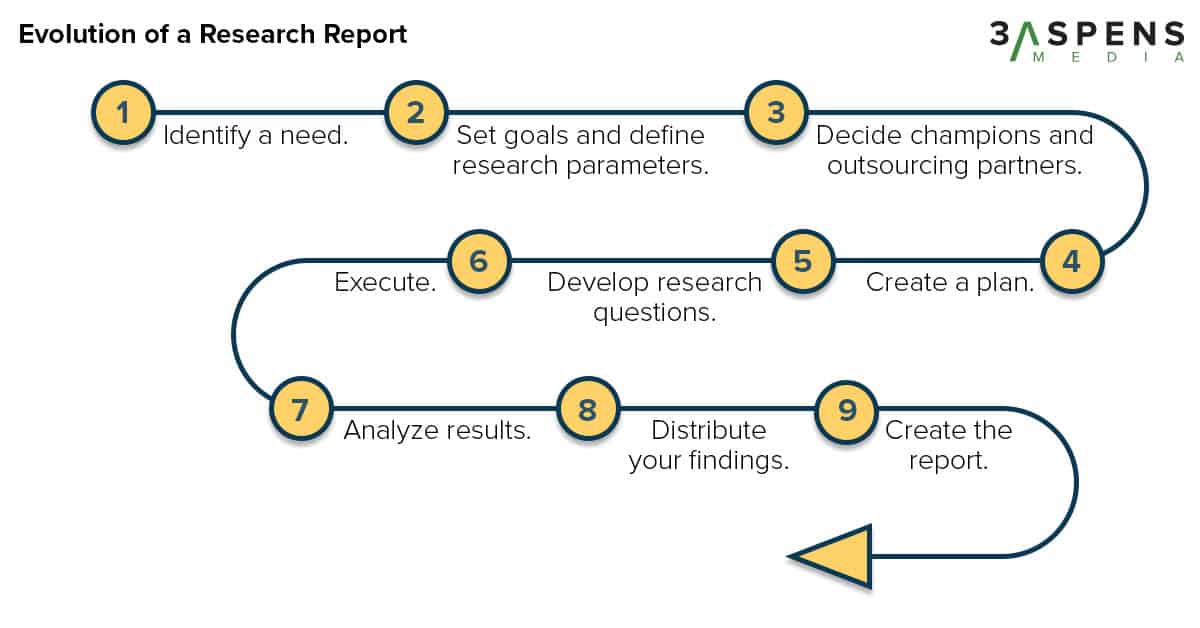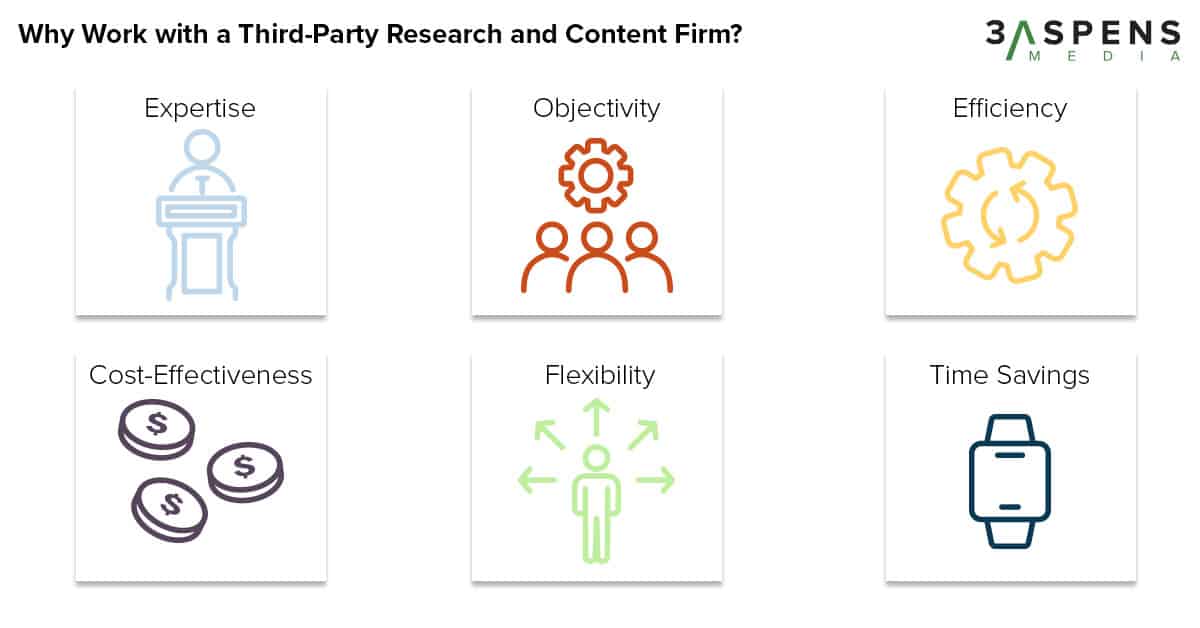Original research powers industry credibility — if you do it well.
Industry trade associations, buying groups and educational institutions looking to improve members’ businesses, create industry standards and represent members’ interests can all benefit from conducting and reporting on original research.
Original research, or primary research, is a methodology organizations use to collect data directly from their audience rather than relying on previously collected data. For this, researchers – whether internal or outsourced – delve into topics that matter most to the organization’s members and audience. They gather insights via:
- Online surveys
Online surveys using tools like SurveyMonkey make data collection simple. Respondents answer open- and close-ended questions and indicate whether they wish to be contacted to discuss their answers further. - Focus Groups
Unlike online surveys that can reach hundreds or more people, focus groups concentrate on a small group of subject matter experts to facilitate deeper discussion. - Interviews
Researchers can conduct interviews with subject matter experts, and as follow-ups to a survey or focus group to gain greater context. The interviewee may choose to be identified or remain anonymous.
Original research provides new and valuable insights into industry changes, opportunities and challenges affecting an organization’s members. Because the researchers aren’t relying on other sources, they can be sure the data collected is meaningful to their audience.

Secondary research methods involve compiling data from various reputable sources such as books, trade journals, library databases and existing research.
Organizations can use primary and secondary research to help members understand historical data and current trends affecting their industries. But first, the data must be translated into language that resonates with the players in the field.
This is where many organizations struggle.
Going the DIY route to conduct research you can use to produce meaningful content can feel daunting, especially for organizations with limited resources or expertise. Some choose to assign the task to an internal member, but that person may already have a full plate or lack the specific skillset required. Others hire an outside agency to assist at different stages of the research – only to find the completed report misses the mark. Keep reading to learn how to avoid these pitfalls.
B2B Companies Also Gain from Original Research and Reports
It’s not just associations and buying groups that benefit from conducting original research. B2B businesses have much to gain when they pursue insights into their industry and operations. Their ambitions could be as lofty as in-depth market reports or as targeted as short surveys and research on single topics like customer service, artificial intelligence, cybersecurity, technology or employee satisfaction. Each effort can have value if it’s done right and used effectively.
For example, we work with companies, buying groups and associations that have produced original research around:
- The industry outlook for their members
- The state of the wood flooring industry
- Building a connected business
- The state of ecommerce in distribution
- The changing nature of leadership and employee culture
Whether you tackle the research on your own or bring in a team to help, you can use original research to:
Attract Potential Customers
High-quality research and reports can serve as powerful marketing tools. By providing valuable insights and actionable recommendations, B2B companies can attract potential customers who are looking for solutions to their business problems.
Build Customer Trust
By sharing research and reports with customers and prospects, B2B companies can build stronger relationships with their audiences. This can lead to increased customer loyalty and repeat business over time.
Create Industry Benchmarks
Organizations that perform original research contribute to their members’ greater understanding of business performance and market fluctuations – so they know if they are crushing it or being crushed.
Create Thought Leadership Content
Using original research can help industry leaders stand out from the crowd. Thought leadership is said to bump brands ahead of competitors with more name recognition. A 2021 joint Edelman and LinkedIn study found 47% of respondents reported thought leadership content led them to find and choose a company over a more well-known brand.
Create Industry Standards of Practice
According to the Association of Internet Research Specialists, the most innovative organizations rely on research to uncover consumer desires, market trends and management practices in business decision making processes. As industry experts and thought leaders publish findings from their original research projects, accepted practices begin to emerge based on performance, innovation and growth.
Develop Effective Public Relations Communications
It’s easy for industry journals to find professionals willing to share their opinions, but it’s not as easy to find data points that support those opinions. Original research and related data can make you a more credible source.
Differentiate from Competitors
In business, the only thing separating the ordinary from the extraordinary is the value customers receive. Customers look for trusted partners when considering their business transactions and the more information a company provides, the more apt customers are to do business with them.
Establish Brand Authority
Creating original research and reports allows B2B companies to establish themselves to compete for market share (and mindshare) and become an authoritative household name. By sharing insights and analysis on industry trends, companies can demonstrate their expertise and build trust and credibility with potential customers.
The Evolution of a Research Report
Ready to launch your next research project but not sure where to start? Whether you go it alone or work with a third-party research company, your project should follow this standard roadmap:

- Identify a need.
Begin with your audience in mind. Talk to your members, customers and colleagues to understand the most pressing issues they face and what topics warrant deeper exploration.
- Set goals and define research parameters.
Without set goals, your research could become convoluted with irrelevant data. Ask yourself: What are you trying to measure? What methods will you use? How will the end data be used? Is there a time frame or budgetary restrictions? Setting S.M.A.R.T. (Specific, Measurable, Achievable, Realistic and Time-Bound) goals help turn vague goals into actionable ones.
- Decide champions and outsourcing partners.
Choose who will be responsible for overseeing the research project and if you will be using a third-party research company to help you plan and execute. (See benefits of working with a third-party research company below.)
- Create a plan.
Keeping your goals in mind, outline the steps your research will require, set deadlines and assign project responsibilities to team members or your outsourced partner. Clarify who the target survey responses will include and how they will be contacted.
- Develop research questions.
Based on the topic(s) you want to learn more about, determine the questions you’ll pose to your target groups. You may consider a mix of close-ended questions (Yes/No, multiple choice) with open-ended questions that allow for deeper insights.
- Execute.
It’s “GO” time. Send out your survey requests and (hopefully) watch the results pile in. Be sure to include time to follow up with potential responders and send follow-up emails or calls to encourage engagement. Some organizations reward participation with gift cards or points programs that can be used to cash in on prizes later. Once a sizable number of responses have been submitted, you’ll want to schedule follow-up interviews with those willing to discuss their answers further.
- Analyze results.
It’s now time to dig into the data. You may use data analysis tools like those available through SurveyMonkey to present data from close-ended questions in graphs or charts. Remember to refer to your goals and research parameters when analyzing the data. This will help you sort data into chunks of information that can be conveyed to your audience.
- Create the report.
With all your data, interviews and analysis complete, it’s time to compile a report (or reports) and any additional content. This stage may be considered the most laborious and includes report writing and creation, layout and graphics, as well as the integration of relevant external sources that provide additional context and insight for your audience.
- Distribute your findings.
All that great data won’t do anyone any good if it isn’t shared. There are many effective ways to distribute research. You can share and promote your final report on your website, through email or printed newsletters, press releases or through guest posts in industry publications. Social media, blog posts, podcasts, webinars, infographics and whitepapers are great ways to amplify reach and get the most mileage out of your efforts.
Should You DIY or Work with an Industry-Focused Content Agency?
Considering partnering with an outside agency? Here’s what you need to know:
The upside of working with third-party research companies is that they have experience compiling and writing reports and can provide an objective point of view you may lose when the work is done in-house. These companies, with permission from your organization, can take on the time-intensive tasks of reaching out to participating members and requesting follow-up interviews or feedback regarding survey answers, freeing up your time and resources.
About 1/3 of all companies that conduct industry research partner with a third-party organization. — Marketing Insider Group
However, if the third-party research company is unfamiliar with your industry, they may struggle to adequately relay key pieces of data to your members. Or, they may inadvertently cause conflict with key stakeholders who may help fund research, sponsor events or pay for ads in industry publications.
In those situations, it’s important to discuss challenges and/or solutions in a clear and transparent way that encourages buy-in and collaboration throughout these relationships.
The ideal research and content firm should have experience in industries relevant to yours as well as access to the relevant talent and experience your organization lacks. For instance, when a practiced researcher interviews a survey respondent to get greater context on a survey response, they are more likely to get in-depth and honest explanations than someone who rarely, if ever, conducts interviews.
Lastly, a third-party firm has years of experience planning and executing a research project from start to finish. They should act as an extension of your internal team, allowing you to complete your research goals in the allotted time while enabling you to focus on your business goals.
Benefits of Hiring a Third-Party Research and Content Firm

- Expertise: Research companies have specialized expertise in conducting research and data analysis. They can help design research studies, collect data, analyze results and provide insights that may not attainable in-house.
- Objectivity: They can provide an objective perspective that may be difficult to achieve within the organization. They can offer unbiased insights and recommendations based solely on the data, without any internal biases or agendas.
- Efficiency: They have the resources and infrastructure to conduct research more efficiently. They can handle large amounts of data, utilize the latest technology and employ experienced professionals to ensure the research is completed expediently and accurately.
- Cost-effectiveness: Hiring a third-party research company can be more cost-effective than conducting research in-house. They have the resources to complete research at a lower cost, without compromising on quality. This frees your employees to tend to their primary tasks and meet your business goals.
- Flexibility: Working with a third-party allows businesses to be more flexible with their needs. They can scale up or down based on their needs and budget, and access a wide range of research services depending on the project requirements. You can go big or start small.
- Time Savings: Often, organizations don’t have excess time, so and well-intended plans for research projects often fall by the wayside. When you outsource to a third-party , they take over the heavy lifting — planning and executing on your behalf.
Why Choose 3 Aspens Media for Research-Based Reports?
Looking to create a custom report for your organization or business? 3 Aspens Media works with:
- Buying groups, associations and educational institutions in distribution
- Software and consulting companies that target distribution and manufacturing
- Distribution and manufacturing companies
From research and execution to reporting and distribution, 3 Aspens Media guides your research efforts alongside content production, graphic design and search engine optimization to help your reports get the most reach and have the most impact.
Some examples of our work include the following:
Research-Based Reports
We can develop original research based on a topic important to your members, or synthesize and repurpose existing research to extend its life and increase member usability. We help with:
- Planning, customized to your needs
- Production, including: Research, writing and design
- Follow-up interviews as needed
- Editing of contributed articles from staff or members
- Distribution and promotion recommendations
- Development of press releases to share high-level results
Industry Outlook Reports (Quarterly or Annual)
We can create quarterly or annual industry outlook reports that offer deeper insights into market conditions impacting your members. We can help you with:
- Survey creation
- Analysis of data
- Interviews of survey respondents for greater context around data
- Creating articles with analysis and insights from members
- Editing of contributed articles from staff or members
- Integration of external sources for additional context
- Creating graphics to showcase data
- Designing the final report
- Development of press releases to share high-level results
Curious about how we at 3 Aspens Media can help your organization conduct and share original research important to your audience? Reach out at info@3aspensmedia.com, or check out further resources on our blog.




